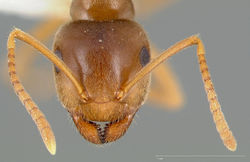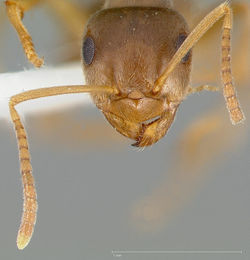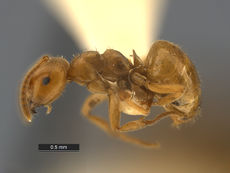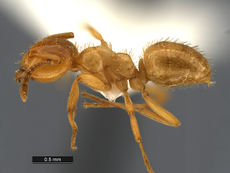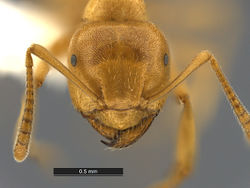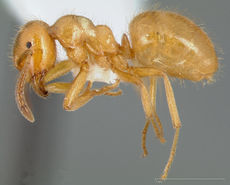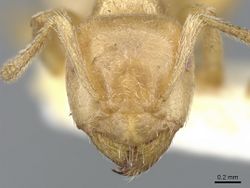Key to North American Lasius Species
The following key to North American Lasius is based on Wilson (1955), Wing (1968) and Mackay & Mackay (2002).
You may also be interested in
- Lasius
- Key to Lasius-Nearctic workers of Acanthomyops - There are four North American keys to the Lasius species in the synonymized subgenus Acanthomyops. The link here takes you to one of these keys. Links to the other three keys are given in the introductory text of that page's key.
1
- Maxillary palps long, 6-segmented . . . . . 2
- Maxillary palps short, 3-segmented . . . . . 19
2
return to couplet #1
- Eye large, at least 10 ommatidia (usually more than 12) in maximum diameter; maximum eye length 0.20 X the head width or more . . . . . 3
- Eye small, less than 12 ommatidia in maximum diameter; maximum eye length 0.17 X the head width or less . . . . . 9
3
return to couplet #2
- In a given nest series all larger workers (PW 0.57 mm. or more) and most smaller workers with one or more offset teeth at the basal angle of the mandible; male mandible with a narrow preapical cleft setting off a narrow, acute apical tooth, and with a well defined basal angle . . . . . Lasius pallitarsis
- Workers of all sizes with the posterior basal tooth aligned with the adjacent teeth of the masticatory border; male mandible lacking a narrow preapieal cleft and well-defined basal angle, the masticatory border curving gradually into the basal border . . . . . 4
4
return to couplet #3
- Maximum eye length usually less than 0.25 X the head width and never more; color always yellowish brown; scapes always lacking standing hairs (southwestern U. S. and Mexico) . . . . . Lasius sitiens
- Maximum eye length exceeding 0.25 X the head width, even if only slightly; color occasionally yellowish brown, but then the scapes have standing hairs . . . . . 5
5
return to couplet #4
- In one or both mandibles of a majority of the nest series, either the penultimate basal tooth is markedly reduced in size relative to the two flanking teeth, or the gap between the penultimate and terminal basal teeth tends to be larger in area than the terminal basal tooth and variable in shape; when viewed with the mandibles opened and the head held in perfect full face (at maximum head length and with the occipital and anterior clypeal borders horizontally aligned), the anterior border of the median clypeal lobe is angulate, i.e, formed of two straight sides meeting at the midline to form an obtuse, usually pointed angle . . . . . 6
- In all of the workers of a nest series, with rare exceptions, the penultimate and terminal basal teeth are subequal in size, and the gap between them has about the same area as the terminal tooth and is constant in shape; when viewed with the mandibles opened and the head held in perfect full face, the anterior border of the median clypeal lobe describes an even, broad parabolic curve, with the sides at least feebly convex and only occasionally meeting in a point at the midline . . . . . 7
6
return to couplet #5
- The scapes and tibiae of all workers except nanitics (PW less than 0.40 mm.) bearing standing hairs; body color light brown to medium brown, very rarely dark brown . . . . . Lasius neoniger
- The scapes and tibiae lacking standing hairs and usually without hairs of any inclination (but pubescence still abundant); color typically dark brown . . . . . Lasius crypticus
7
return to couplet #5
- Within the size range PW 0.53-0.70 mm., scapes and tibiae bearing few or no standing hairs, the seta count always less than 20 and usually less than 10 . . . . . Lasius americanus
- Within the above size range, the scapes and tibiae bearing numerous standing hairs, the seta count usually greater than 10 (western U. S. only) . . . . . 8
8
return to couplet #7
- Medium to dark brown; penultimate and terminal basal teeth of worker subequal in size, gap between them has about the same area as terminal tooth and is constant in shape; occurring in mesic sites . . . . . Lasius niger
- Yellow or yellowish brown; penultimate basal tooth of worker markedly reduced in size relative to 2 flanking teeth, or gap between penultimate and terminal basal teeth larger in area than terminal basal tooth, variable in shape; occurring in arid and semiarid habitats . . . . . Lasius xerophilus
9
return to couplet #2
- Dorsal crest of the worker petiole seen in frontal view strongly convex and non-emarginate . . . . . Lasius humilis
- Dorsal crest of the worker petiole at most feebly convex and often emarginate . . . . . 10
10
return to couplet #9
- Eyes with less than 35 ommatidia . . . . . 11
- Eyes with 35 or more ommatidia . . . . . 13
11
return to couplet #10
- Outer surfaces of each tibia with numerous standing hairs prominent above the ground pubescence (western U. S.) . . . . . Lasius fallax
- Outer surfaces of each tibia with at most one or two standing hairs . . . . . 12
12
return to couplet #11
- Terminal segment of the maxillary palp longer than the penultimate segment in at least a majority of the workers of the nest series (eastern North America to Wyoming) . . . . . Lasius nearcticus
- Terminal segment of the maxillary palp in all of the workers of the nest series at most as long as the penultimate segment (Nova Scotia to California) . . . . . Lasius flavus
13
return to couplet #10
- At least a broad longitudinal median strip of the second gastric tergite, exclusive of the extreme posterior portion, almost completely devoid of pubescence of any kind and with only a few widely scattered standing hairs, its cuticular surface extremely smooth and shining at low magnifications (eastern U. S.) . . . . . Lasius speculiventris
- Central area of second gastric tergite covered by abundant pubescence and standing hairs, its surface feebly shining to subopaque at low magnifications . . . . . 14
14
return to couplet #13
- Longest hairs of the posterior half of the first gastric tergite, exclusive of the extreme posterior strip, not exceeding in length 0.50 X the maximum width of the hind tibia at its midlength . . . . . Lasius umbratus
- Longest hairs of the posterior half of the first gastric tergite, exclusive of the extreme posterior strip, at least 0.60 X as long as the maximum width of the hind tibia at its midlength . . . . . 15
15
return to couplet #14
- Worker: body color brownish yellow; lateral tibial surfaces completely lacking standing hairs; longest hairs of the posterior half of the first gastric tergite, exclusive of the extreme posterior strip, often as long as the maximum width of the hind tibia at midlength or longer; pubescence of gastric tergites dense, often lending a greyish overcast to the cuticle under low magnifications; queen small, HW 1.02-1.17 mm. (eastern North America) . . . . . Lasius minutus
- Worker: body color clear yellow; lateral tibial surfaces often with standing hairs; longest hairs of the posterior half of the first gastric tergite, exclusive of the extreme posterior strip, never exceeding 0.80 X the maximum width of the hind tibia at midlength; pubescence of gastric tergites lighter, rarely dense enough to lend a greyish overcast to the cuticle; queen larger, HW never less than 1.30 mm . . . . . 16
16
return to couplet #15
- Pilosity of posterior half of first gastric tergite, exclusive of the extreme posterior strip, at least in part decumbent-subdecumbent; standing hairs sparse or absent on the lateral tibial surfaces (maritime Canada to Arizona) . . . . . Lasius subumbratus
- Pilosity of posterior half of first gastric tergite, exclusive of the extreme posterior strip, almost entirely suberect-erect; standing hairs often abundant on the lateral tibial surfaces, sometimes reduced but still present (Pacific Coast to Idaho, Nevada) . . . . . 17
17
return to couplet #16
- Posterior margin of head more strongly concave; body more elongate, pro-mesonotum lower and less rounded, metanotal groove a broad angle, propodeum lower and more rounded . . . . . Lasius atopus
- Posterior margin of head flat or essentially flat; body more compact, pro-mesonotum higher and more rounded, metanotal groove more sharply angled, propodeum higher and more anglular . . . . . 18
18
return to couplet #17
- Larger, head width greater than 1.25 mm; apex of petiolar node convex in anterior view; head and gaster matte and only weakly shiny (British Columbia, Washington, Idaho, Oregon, northern California) . . . . . Lasius vestitus
- Smaller, head width less than 0.95 mm; apex of petiolar node concave in anterior view; head and gaster smooth and more strongly shiny (Nevada, Utah) . . . . . Lasius nevadensis
19
return to couplet #1
- Many standing body hairs with plumose tips . . . . . Lasius plumopilosus
- All standing body hairs simple, or weakly to strongly barbulate; never plumose distally . . . . . 20
20
return to couplet #19
- Gula without standing hairs, or rarely with, at most 1 or 2, which are much shorter than those on clypeus. Standing hairs on dorsum of gaster measuring 0.20 to 0.25 mm, almost invariably confined to posterior edges of tergites beyond first. Pubescence on gula and gaster extremely dilute . . . . . Lasius arizonicus
- Gula usually with standing hairs, length and distribution of those on gaster varying; in the few cases where hairs are absent on gula, then standing hairs on dorsum of gaster are not confined to posterior edges of tergites beyond first, and/or pubescence on gula and gaster is from moderate to very dense . . . . . 21
21
return to couplet #20
- Length of longer standing hairs on dorsum of gaster 0.23 mm or more, on gula usually 0.20 mm or more. In side view, crest of petiolar scale sharp to moderately sharp; in anterior view, usually emarginate. Standing hairs on dorsum of gaster either strictly confined to posterior edges of tergites beyond first, or, if more or less widely distributed, then concentrated toward caudal margins . . . . . 22
- Standing hairs on dorsum of gaster rarely more than 0.22 mm long, but if so, those on gula are less than 0.20 mm. Crest of petiolar scale varying as to sharpness and emargination. Standing hairs on dorsum of gaster varying, but usually more or less uniformly distributed over its surface, unless petiolar scale is moderate to blunt in side view, then there may be a relatively greater number of hairs on the caudal margins of tergites . . . . . 23
22
return to couplet #21
- HW 1.08 mm or greater, CI at least 98, usually 100 or more, SI usually 85 or less, and AL usually 1.40 mm or greater. Standing hairs on dorsum of gaster almost invariably confined to posterior edges of tergites beyond first, which has basal hairs. Pubescence on head moderate to dense. Mandible with 1 or more denticles on its basal margin . . . . . Lasius interjectus
- HW 1.02 mm or less, CI usually 96 or less, SI 86 or more, and AL 1.30 mm or less. Standing hairs on dorsum of gaster more irregularly distributed over surface, but with majority of hairs on posterior edges of tergites beyond first. Pubescence on head dilute to very dilute. Mandible rarely with a denticle on its basal margin . . . . . Lasius colei
23
return to couplet #21
- In side view, crest of erect petiolar- scale well below level of propodeal spiracle, blunt; in anterior view, with a standing hair on each corner. Gaster very densely pubescent, body color brownish yellow. SI 83 or more . . . . . Lasius pubescens
- In side view, crest of erect petiolar scale either at or above level of propodeai spiracle, or not blunt; or, in anterior view, with at least a row of hairs. Pubescence on gaster, body color, and SI varying . . . . . 24
24
return to couplet #23
- In side view, crest of petiolar scale very to moderately blunt; in anterior view, convex, straight, or in rare cases with a slight median emargination. Standing hairs on gula almost always distributed over entire surface as viewed from the side . . . . . 25
- In side view, crest of petiolar scale moderately to very sharp; in anterior view, usually broadly emarginate. In a few cases crest may be straight or, more rarely, slightly convex. Standing hairs on gula almost always covering only the posterior ¾ or ½ of its surface, but in a few specimens, especially claviger from in or near North Carolina and Virginia, the entire gula may be covered with standing hairs . . . . . 27
25
return to couplet #24
- Standing hairs noticeably more numerous on propodeum than elsewhere on dorsum of alitrunk. Lateral surface and flexor edge of fore femur usually with 10 or fewer standing hairs, 0.05 mm or less in length. Length of standing hairs on gula, propodeum, and dorsum of gaster usually 0.10 mm or less. Antennal scapes with appressed pubescence . . . . . Lasius murphyi
- Standing hairs more or less evenly distributed over dorsum of alitrunk. Other characters varying . . . . . 26
26
return to couplet #25
- Number of standing hairs on gula 20 or more, often as many as 40, usually 0.12 mm or more in length. Lateral surface and flexor edge of fore femur usually with 12 or more standing hairs 0.06 mm or more in length. Longer standing hairs on dorsum of gaster 0.13 mm or more. Pubescence on antennal scapes varying from fully appressed to strongly suberect . . . . . Lasius latipes and Lasius pogonogynus
- NOTE: An occasional aberrant specimen of claviger (eastern U.S.) or coloradensis (western U.S.) may also key here.
- Workers of L. latipes and L. pogonogynus are very similar and not readily separable. The queens, however, can be separated as follows:
- Body hairs of queen unevenly distributed, bent, tangled and twisted, but not matted to surface; underside of head with most hairs appressed; rare . . . . . . Lasius pogonogynus
- Body hairs of queen evenly distributed, not as above . . . . . . Lasius latipes
- Number of standing hairs on gula 16 or fewer, not more than 0.10 mm long. Lateral surface and flexor edge of fore femur with 10 or fewer standing hairs, usually not more than 0.06 mm long. Longer standing hairs on dorsum of gaster usually 0.12 mm or less. Pubescence on antennal scapes decumbent to strongly suberect . . . . . Lasius murphyi X subglaber hybrid
27
return to couplet #24
- Standing body hairs either simple and delicate, or strongly barbulate. Standing hairs on fore femur varying, but if hairs delicate, then usually 5 or less, often only 2 or 3, and usually 0.05 mm or less in length, often only 0.03 or 0.04 mm. Longer standing hairs on gula usually less than 0.10 mm. In side view, crest of petiolar scale moderate; in anterior view, slightly convex, straight or shallowly emarginate. Pubescence on antennal scapes almost always suberect. SI 78 or less . . . . . 28
- No standing body hairs strongly barbulate or unusually delicate, all simple or weakly barbulate. Standing hairs on fore femur somewhat variable, but usually either 6 or more, often as many as 15; or 0.06 mm or longer, often as long as 0.20 mm, or both. Longer standing hairs on gula usually 0.10 mm or more in length. In side view, crest of petiolar scale very to moderately sharp; in anterior view, usually emarginate, often deeply so. Pubescence on antennal scapes and SI varying . . . . . 29
28
return to couplet #27
- Standing body hairs simple and usually delicate . . . . . Lasius subglaber
- Many standing body hairs strongly barbulate and coarse . . . . . Lasius subglaber X plumopilosus hybrid
29
return to couplet #27
- In side view, clypeus with a peculiar, deep indentation below the middle; otherwise characters agree reasonably well with a small worker of claviger. Sample 5. . . . . . Lasius claviger
- In side view, clypeus of normal conformation . . . . . 30
30
return to couplet #29
- Pubescence on sides of second tergite of gaster dense to very dense, distance between bases of pubescence hairs usually averaging well below 1/3 of their length, often contiguous. Most of body and appendages quite densely pubescent . . . . . 31
- Pubescence on sides of second tergite of gaster dilute to moderate, distance between bases of pubescence hairs usually averaging more than 'h of their length, often several times their length. Rest of body and appendages somewhat variable, but usually never more than moderately pubescent . . . . . 32
31
return to couplet #30
- In anterior view, crest of petiolar scale usually with a distinct median emargination; sides more or less straight. Longer standing hairs on gula usually less than 0.12 mm. As seen in perfect full-face view, 18 or more standing hairs on occiput, the border of which is medially emarginate in many specimens. Body and appendages yellow to brownish yellow . . . . . Lasius occidentalis
- In anterior view, crest of petiolar scale straight or shallowly emarginate; sides convex. Longer standing hairs on gula usually 0.12 mm or more in length. As seen in perfect full-face view, 16 or fewer standing hairs on occiput, the border of which is straight. Body and appendages yellowish brown to brown . . . . . Lasius bureni
32
return to couplet #30
- Essentially all pubescence on antennal scapes conspicuously suberect. Pubescence hairs on gula and fore femur mostly suberect . . . . . 33
- Pubescence hairs on antennal scapes either all appressed, a few decumbent to suberect, or many hairs decumbent. Pubescence on gula and fore femur appressed or decumbent . . . . . 34
33
return to couplet #32
- Length of standing hairs on gula 0.13 mm or more, on dorsum of gaster 0.18 mm or more. Pubescence delicate. Color yellow . . . . . Lasius creightoni.
- Length of standing hairs on gula usually 0.12 mm or less, on gaster usually 0.17 mm or less. Pubescence coarser. Color yellowish brown to brown . . . . . Lasius coloradensis
34
return to couplet #32
- Length of longer standing hairs on the following structures usually not over the stated amounts: clypeus, 0.11 mm; occiput, 0.10 mm; fore femur 0.06 mm; and dorsum of propodeum, 0.12 mm. Propodeum usually convex in profile. In side view, crest of erect petiolar scale above to well above level of propodeal spiracle . . . . . Lasius mexicanus
- Length of longer standing hairs on clypeus, occiput, fore femur, and propodeum usually exceeds amounts stated above, often by nearly 100 percent. Propodeum rarely convex in profile. In side view, height of erect petiolar scale with respect to propodeal spiracle varying, but crest often at or below level of propodeal spiracle . . . . . 35
35
return to couplet #34
- Standing hairs on fore femur usually numbering 6 or fewer; on hind femur, none. Longer hairs on crest of petiolar scale usually 0.13 mm or more. A few standing hairs on dorsum of alitrunk moderately to strongly flexed. In many specimens standing hairs few or lacking in a central area of varying size on dorsum of gaster. Mandible sometimes with a denticle on its basal margin. SI 81 or more . . . . . Lasius californicus
- Standing hairs on fore femur usually numbering 7 or more, on hind femur, 0 to 5. Longer hairs on crest of petiolar scale usually 0.12 mm or less. Standing hairs on alitrunk usually all more or less straight, those on dorsum of gaster more or less evenly distributed over its surface. Mandible without a denticle on its basal margin. SI 80 or less for most specimens . . . . . 36
36
return to couplet #35
- Most specimens falling above the critical dividing line, SL = 1.27 (HW) - 0.505. (A few small specimens of claviger, including its synonym parvulus, fall here). New Mexico to Manitoba and west. See text for further discussion . . . . . Lasius coloradensis
- Most specimens falling on or below the critical dividing line, SL = 1.27(HW) - 0.505. Kansas to Minnesota and east. See species for further discussion . . . . . Lasius claviger
References
- Mackay, W. P. and E. Mackay. 2002. The ants of New Mexico (Hymenoptera: Formicidae). Edwin Mellen Press, Lewiston, NY.
- Wing, M. W. 1968. Taxonomic revision of the Nearctic genus Acanthomyops (Hymenoptera: Formicidae). Cornell University, New York State College of Agriculture, Agricultural Experiment Station, Ithaca, NY, Memoir No. 405. 173 pages.
- Wilson, E. O. 1955a. A monographic revision of the ant genus Lasius. Bulletin of the Museum of Comparative Zoology 113: 1-201.
